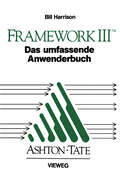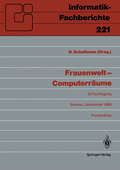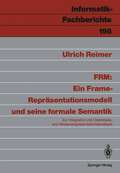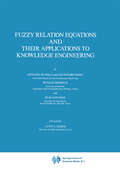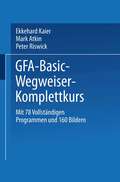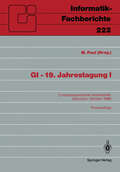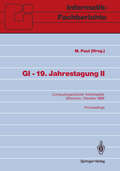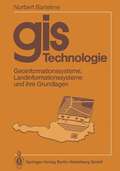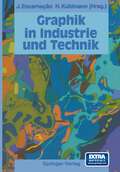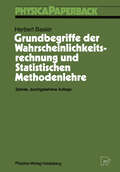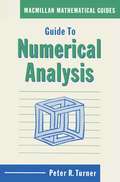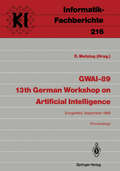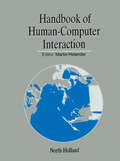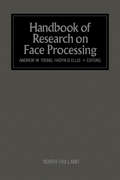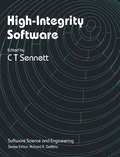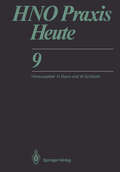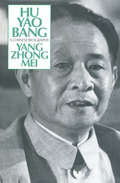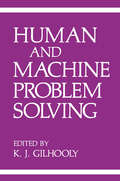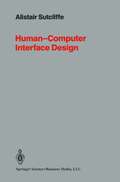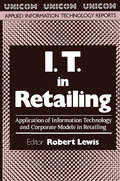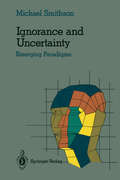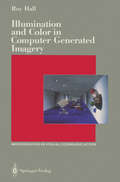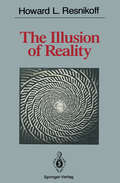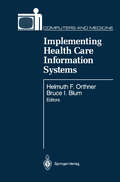- Table View
- List View
Frauenwelt — Computerräume: Fachtagung, veranstaltet von der Fachgruppe „Frauenarbeit und Informatik” im Fachbereich 8 der GI Bremen, 21.–24. September 1989 (Informatik-Fachberichte #221)
by Heidi SchelhoweFRM: Zur Integration von Datenbank- und Wissensrepräsentationsansätzen (Informatik-Fachberichte #198)
by Ulrich ReimerDas Buch stellt FRM vor, ein Frame-basiertes Modell zur Repräsentation von Wissen. Der Schwerpunkt liegt dabei auf der Ausarbeitung der Semantik seiner Repräsentationskonstrukte. Zur formalen Spezifikation dieser Semantik werden Integritätsbedingungen formuliert, die unzulässige, in jedem Fall bedeutungslose Repräsentationsstrukturen ausschließen. Damit wird die Basis gelegt für ein Wissensverwaltungssystem, das die Einhaltung dieser Integritätsbedingungen überwacht und somit die Gewährleistung der Validität einer Wissensbasis zu einem beträchtlichen Teil übernehmen kann. Ein(e) Wissensingenieur(in), der/die insbesondere beim Aufbau großer, vernetzter Wissensbasen Schwierigkeiten hat, die Übersicht zu bewahren, kann dadurch erheblich entlastet werden, und es wird somit ein Beitrag geleistet, die bei der Erstellung großer Wissensbasen entstehende Komplexitätsbarriere aufzubrechen. Neben der Spezifikation der Repräsentationsstrukturen von FRM werden auch Anfrage- und integritätserhaltende Änderungsoperationen diskutiert, womit ein häufig in Wissensrepräsentationssprachen anzutreffendes Defizit vermieden wird. Die Darstellung schlägt eine Brücke zwischen Ansätzen aus dem Datenbankbereich und dem Bereich der Künstlichen Intelligenz (KI). So ist der Gegenstand eines Frame-Repräsentationsmodells mit seinen mächtigen Modellierungsmöglichkeiten eindeutig ein KI-Thema, während die Aspekte der Integritätserhaltung, die sich aus dem Bedarf nach einer Unterstützung großer Datenmengen ableiten, eher typisch für die Betrachtungsweise im Datenbankbereich sind. Entsprechend werden Bezüge hergestellt zwischen FRM und einschlägigen Arbeiten aus dem Datenbankbereich und der KI sowie ferner der Linguistik und der Kognitionspsychologie.
Fuzzy Relation Equations and Their Applications to Knowledge Engineering (Theory and Decision Library D: #3)
by Antonio Di Nola S. Sessa Witold Pedrycz E. SanchezIt took many decades for Peirce's coneept of a relation to find its way into the microelectronic innards of control systems of eement kilns, subway trains, and tunnel-digging machinery. But what is amazing is that the more we leam about the basically simple coneept of a relation, the more aware we become of its fundamental importanee and wide ranging ramifications. The work by Di Nola, Pedrycz, Sanchez, and Sessa takes us a long distanee in this direction by opening new vistas on both the theory and applications of fuzzy relations - relations which serve to model the imprecise coneepts which pervade the real world. Di Nola, Pedrycz, Sanchez, and Sessa focus their attention on a eentral problem in the theory of fuzzy relations, namely the solution of fuzzy relational equations. The theory of such equations was initiated by Sanchez in 1976, ina seminal paper dealing with the resolution of composite fuzzy relational equations. Sinee then, hundreds of papers have been written on this and related topics, with major contributions originating in France, Italy, Spain, Germany, Poland, Japan, China, the Soviet Union, India, and other countries. The bibliography included in this volume highlights the widespread interest in the theory of fuzzy relational equations and the broad spectrum of its applications.
GI — 19. Jahrestagung I: Computergestützter Arbeitsplatz München, 18.–20. Oktober 1989 Proceedings (Informatik-Fachberichte #222)
by M. PaulDie in den vergangenen Jahren außerordentlich gesteigerte Leistungsfähigkeit sowohl der Arbeitsplatzrechner als auch der Kommunikationstechnik für ihre Vernetzung erschließen sinnvolle Anwendungsmöglichkeiten für immer weitere und umfangreichere Arbeitsbereiche. Die 19. Jahrestagung der GI greift wichtige Fragen hierzu auf und setzt sich mit einer Fülle von Einzelthemen auseinander. Dabei wendet sie sich gleichermaßen an Entwickler, Anwender, Wissenschaftler und Studenten.
GI — 19. Jahrestagung II: Computergestützter Arbeitsplatz München, 18.–20. Oktober 1989 (Informatik-Fachberichte #223)
by M. PaulDie in den vergangenen Jahren außerordentlich gesteigerte Leistungsfähigkeit sowohl der Arbeitsplatzrechner als auch der Kommunikationstechnik für ihre Vernetzung erschließen sinnvolle Anwendungsmöglichkeiten für immer weitere und umfangreichere Arbeitsbereiche. Die 19. Jahrestagung der GI greift wichtige Fragen hierzu auf und setzt sich mit einer Fülle von Einzelthemen auseinander. Dabei wendet sie sich gleichermaßen an Entwickler, Anwender, Wissenschaftler und Studenten.
GIS Technologie: Geoinformationssysteme, Landinformationssysteme und ihre Grundlagen
by Norbert BartelmeIn GIS - Technologie wird der Einsatz digitaler Methoden zur Verwaltung, Darstellung und Auswertung ortsbezogener Informationen beschrieben. Es wird ein Konzept vorgestellt, das einerseits die Anforderungen eines Katasters an Detailreichtum und Punktgenauigkeit erfüllt, andererseits die großräumige rasterorientierte Anwendung im Rahmen der Geowissenschaften und der Umweltplanung zuläßt. Das logische Gesamtkonzept wird verständlich beschrieben und ist deshalb für einen breiteren Leserkreis gedacht.
Graphik in Industrie und Technik (Beiträge zur Graphischen Datenverarbeitung)
by Jose Encarnacao Karl H. Ditze Herbert W. Kuhlmann K. ZuseMit diesem anläßlich des 125jährigen Firmenjubiläums von ARISTO herausgegebenen Buch wird dem Leser ein detaillierter Einblick in die umfangreichen Aufgaben der Praxis vermittelt, in denen die Graphische Datenverarbeitung erfolgreich ihren Einzug genommen hat. Dabei wird von den ersten Anfängen bis zu modernsten Techniken anhand von Anwendungsgebieten beispielhaft dargestellt, welche Möglichkeiten bestehen, und wie diese sich in der Praxis auswirken. Anhand von praktischen Tätigkeitsfeldern soll dieses Buch zeigen, wie sich die Technik entwickelt hat, wo sie heute steht, und was für die Zukunft zu erwarten ist. Es leistet damit einen Beitrag zum Technologieverständnis und soll helfen, Hemmungen und Vorbehalte abzubauen.
Grundbegriffe der Wahrscheinlichkeitsrechnung und Statistischen Methodenlehre (Physica-Lehrbuch)
by Herbert Baslerten Beispiele und Aufgaben überprüft. Dem Verleger, Herrn Liebing, danke ich für sein bis in sachliche Einzelheiten gehendes Interesse, das er dem Entstehen dieses Buches entgegengebracht hat. Herbert Basler Würzburg, im April 1968 Vorwort zur 7. Auflage Das Konzept des Buches war und ist, ftir Nicht·Mathematiker eine mathematisch saubere, aber soweit wie möglich von mathematischer Technik entlastete Einfüh· rung in die Wahrscheinlichkeitsrechnung und angewandte Mathematische Statistik zu bieten. Während der vorangegangenen Auflagen habe ich bemerkt, daf~ auch bei Mathematikern ein Bedürfnis nach einer solchen Einführung als einer Propädeutik für einschlägige rein mathematische Kurse besteht. Insbesondere diese Bindeglied· Funktion zwischen mathematischer Theorie und Anwendungen habe ich in der vor· liegenden Auflage weiter auszubauen versucht, da ich beispielsweise beobachte, daf~ es Mathematik-Studenten, die an Kursen für Nicht-Mathematiker teilnehmen, oft nicht mehr möglich ist, die vermeintliche Kluft zwischen so einer Statistischen Me thodenlehre und einer maß theoretisch fundierten Wahrscheinlichkeitstheorie und Mathematischen Statistik zu überbrücken und den Zusammenhang zu sehen. In die se Richtung gehen die Erweiterungen am Schluß von 1. 4. 3 (S. 48), am Schluß von 2. 1 (Charakterisierungssatz für Verteilungsfunktionen, S. 65f. ), im neuen Abschnitt 2. 2. 1 (Verwendung des Terminus "Grundgesamtheit", S. 73f. ) sowie der Abschnitt 3. 1 Stichproben. Dabei habe ich vielfach Kleindruck verwendet um "stärker vor wärts drängenden Lesern" die Möglichkeit zu geben, den Faden zu behalten, wenn sie solche Passagen übergehen wollen. Auf~erdem habe ich viele Teile neu formuliert, so z. B.
Guide to Numerical Analysis (Mathematical Guides)
by Peter R TurnerThis book considers some of the most fundamental ideas of mathematical and in particular, numerical computing. These in turn form the basis of most of the techniques of scientific computing which are widely used in almost every branch of scientific work and in business and economic applications.
GWAI-89 13th German Workshop on Artificial Intelligence: Eringerfeld, 18.–22. September 1989 Proceedings (Informatik-Fachberichte #216)
by Dieter MetzingDie 13. Jahrestagung für Künstliche Intelligenz, GWAI-89, ist auch 1989 wieder ein Forum, auf dem ein beachtliches Spektrum der KI-Forschung in der Bundesrepublik präsentiert wird. Es reicht von Vorträgen über aktuelle Forschungsarbeiten bis zu speziellen Seminaren und dort von Grundlagenveranstaltungen (Formale und Kognitive Grundlagen von Wissensrepräsentationen; Einführung in Maschinelles Lernen und in spezielle höhere problemorientierte Sprachen für Wissensbasierte Systeme) bis zur Sektion "Expertensystemlabor", in der das Ziel verfolgt wird, einen Rahmen zu definieren für kontinuierliche Kooperation und Erfahrungsaustausch zwischen Grundlagen- und Anwendungsforschung und Produktentwicklung. Die thematischen Schwerpunkte der Beiträge liegen in den Gebieten klassische und nicht-klassische Deduktive Systeme, Expertensysteme und Natürlichsprachliche Systeme. Dazu kommen andere Teilgebiete der KI wie Bildverarbeitung, Kognitive und Tutorielle Systeme sowie Neuronale Netze.
Handbook of Human-Computer Interaction
by Martin HelanderThis Handbook is concerned with principles of human factors engineering for design of the human-computer interface. It has both academic and practical purposes; it summarizes the research and provides recommendations for how the information can be used by designers of computer systems. The articles are written primarily for the professional from another discipline who is seeking an understanding of human-computer interaction, and secondarily as a reference book for the professional in the area, and should particularly serve the following: computer scientists, human factors engineers, designers and design engineers, cognitive scientists and experimental psychologists, systems engineers, managers and executives working with systems development.The work consists of 52 chapters by 73 authors and is organized into seven sections. In the first section, the cognitive and information-processing aspects of HCI are summarized. The following group of papers deals with design principles for software and hardware. The third section is devoted to differences in performance between different users, and computer-aided training and principles for design of effective manuals. The next part presents important applications: text editors and systems for information retrieval, as well as issues in computer-aided engineering, drawing and design, and robotics. The fifth section introduces methods for designing the user interface. The following section examines those issues in the AI field that are currently of greatest interest to designers and human factors specialists, including such problems as natural language interface and methods for knowledge acquisition. The last section includes social aspects in computer usage, the impact on work organizations and work at home.
Handbook of Research on Face Processing
by A. W. Young H. D. EllisThe high degree of scientific interest in face processing is readily understandable, since people's faces provide such a wealth of social information. Moreover, investigations have produced evidence of highly precocious face processing abilities in infants, and of neural mechanisms in adults that seem to be differentially involved in face perception. Such findings demonstrate that, as one might expect, the psychological importance of the face has clear biological underpinnings.There are also urgent practical reasons for wanting to understand face processing. The most extensively investigated of these involve forensic issues. Other applications include the development of automated recognition systems for security and other purposes, and understanding and rehabilitating disorders and impairments linked to brain injuries and psychiatric conditions.Current studies of face processing are grouped in the volume into eleven topic areas. For each area, the editors approached an acknowledged authority and commissioned a review chapter summarising the findings that have been made. These chapters were then circulated to other experts who were asked to write brief commentaries that developed theoretical or empirical points of importance to each area. In this way, a balanced coverage of each topic is achieved.The book begins with a section examining the evidence suggesting that there may be something `special' about face processing. This is followed by consideration of the face as a visual pattern. Then there are four sections dealing with major uses of facial information, followed by sections discussing the development of face processing abilities and the neural mechanisms involved. The last three sections of the book deal with topics for which there are important practical applications for the studies reported.
High-Integrity Software (Software Science and Engineering)
by C. T. Sennett4. 3 The Gypsy language 72 4. 4 The Gypsy Verification Environment 73 4. 5 A simple example 81 4. 6 Specification data types 91 4. 7 Future directions 95 100 4. 8 Conclusions 5 Reliable programming in standard languages 102 Bernard Carre, Program Validation Ltd. 5. 1 Introduction 102 5. 2 Language requirements for high-integrity programming 103 5. 3 The use of standard languages 108 5. 4 Programming in Pascal and Ada 110 1'19 5. 5 Practical experiences NewSpeak: a reliable programming language 6 122 I. F. Currie, Royal Signals and Radar Establishment 6. 1 Introduction 122 6. 2 Types and values 127 6. 3 Declarations and variables 132 6. 4 Guarded declarations 134 6. 5 Cases and conditionals 136 6. 6 Loops 138 6. 7 Procedures 140 6. 8 Assertions 145 6. 9 Timing 147 6. 10 Conclusion 149 6. 11 Appendix 1: summary of syntax 150 6. 12 Appendix 2: type lattice and widening 156 7 Program analysis and systematic testing 159 M. A. Hennell, University of Liverpool, and D. Hedley and I. J. Riddell, Liverpool Data Research Associates Ltd. 7. 1 Introduction 159 7. 2 The basic requirement 160 7. 3 The Liverpool experience 161 7. 4 The Liverpool experiments 162 7. 5 The LDRA Testbeds 163 Interpretation 169 7. 6 7. 7 Applicability and benefits 171 7. 8 Safety-critical systems 173 VI 8 Program analysis and verification 176 Bernard Carre, Program Validation Ltd. 8. 1 Introduction 176 8.
HNO Praxis Heute (HNO Praxis heute #9)
by W. Behrendt E. Biesinger K. Fleischer H. Ganz I. Görisch M. Moser F. W. Oeken W. Schätzle O. Staindl H. J. Wilhelm G. WolfDie jährlich erscheinende Reihe bietet eine praxisbezogene Fort- und Weiterbildung speziell für den niedergelassenen HNO-Arzt und den Klinikassistenten. Die Themen werden so gewählt, daß in regelmäßigem Turnus alle für die HNO-Praxis wichtigen Bereiche je nach Aktualität abgehandelt werden. Der HNO-Arzt kann sich mit dieser Reihe eine komprimierte und ständig aktuelle Bibliothek der praktischen Hals-Nasen-Ohren-Heilkunde aufbauen, die ihm modernes Fachwissen und das nötige "know-how" vermittelt. Die entzündlichen Komplikationen der Otitis media haben im Antibiotikazeitalter einen Gestaltwandel erfahren. Fehldiagnosen vermeiden zu helfen ist das Ziel des ersten Beitrages. Von den Verletzungen im Gesichtsbereich sind die lateralen Frakturen (Jochbein, Jochbogen, blow out) ebenso häufig wie therapeutisch denkbar. Unterschiedliche Gesichtspunkte bei der operativen Versorgung müssen berücksichtigt bzw. koordiniert werden. Die Tonsillitiden sowie die Crux chronische Pharyngitis mit deren Differentialdiagnose gehören zur täglichen Praxis. Inwieweit spielt die chronische Laryngitis eine Rolle bei der Entstehung des Larynxkarzinoms, und wie behandelt man Präkanzerosen im Kehlkopf? Fragen, die immer wieder diskutiert werden. Wie versorgt man Narben im Gesicht? Dieses Problem stellt sich auch jedem niedergelassenen Arzt. Der Beitrag informiert über die vielfältigen Möglichkeiten. Die fundierte Darstellung des Problems Barotraumen wird dem Leser ebenso empfohlen wie die systematische und praxisorientierte Beschreibung der Auswirkungen funktioneller Störungen der Halswirbelsäule mit ihren HNO-Symptomen.
Hu Yao-Bang: A Chinese Biography
by Zhongmei YangCompares IT parks within the Asian Pacific in search of strategies that policy makers can adopt to: reduce the global digital divide; advance distributional equity; and soften some of the negative effects of economic globalization. "Best practices" are suggested based on these cases.
Hu Yao-Bang: A Chinese Biography
by Zhongmei YangCompares IT parks within the Asian Pacific in search of strategies that policy makers can adopt to: reduce the global digital divide; advance distributional equity; and soften some of the negative effects of economic globalization. "Best practices" are suggested based on these cases.
Human and Machine Problem Solving
by K. J. GilhoolyProblem solving is a central topic for both cognitive psychology and artificial intelligence (AI). Psychology seeks to analyze naturally occur ring problem solving into hypothetical processes, while AI seeks to synthesize problem-solving performance from well-defined processes. Psychology may suggest possible processes to AI and, in turn, AI may suggest plausible hypotheses to psychology. It should be useful for both sides to have some idea of the other's contribution-hence this book, which brings together overviews of psychological and AI re search in major areas of problem solving. At a more general level, this book is intended to be a contribution toward comparative cognitive science. Cognitive science is the study of intelligent systems, whether natural or artificial, and treats both organ isms and computers as types of information-processing systems. Clearly, humans and typical current computers have rather different functional or cognitive architectures. Thus, insights into the role of cognitive ar chitecture in performance may be gained by comparing typical human problem solving with efficient machine problem solving over a range of tasks. Readers may notice that there is little mention of connectionist ap proaches in this volume. This is because, at the time of writing, such approaches have had little or no impact on research at the problem solving level. Should a similar volume be produced in ten years or so, of course, a very different story may need to be told.
I.T. in Retailing: Application of Information Technology and Corporate Models in Retailing
by Robert LewisRetailing today is one of the largest, most buoyant and most competitive market sectors. The large, medium and small retailers, providers of systems are the major players in this market. The exploitation of information technology and the use of quantitative corporate models are emerging as key factors in determining the strength and effectiveness of marketing plans and support logistics. Many major retailers have developed considerable in-house expertise in this area and many hard ware manufacturers and systems houses have created special divisions to provide turn-key installations, products and services in order to exploit these opportunities. However, in the research leading up to the seminar on which this book is based, a number of important gaps in retailer useage of systems were noted. While many retailers, including the large multiples, had very sophisticated electronic point of sales devices, the information that was available was not being used to plan effective marketing and selling strategies, nor yet to plan for growth. In the medium and smaller companies there was still concern whether electronic point of sales were cost effective for them or whether being without such aids put them at a grave disadvantage vis-a-vis their larger competitors.
Ignorance and Uncertainty: Emerging Paradigms (Cognitive Science)
by Michael SmithsonIgnorance and Uncertainty overviews a variety of approaches to the problem of indeterminacies in human thought and behavior. This book examines, in depth, trends in the psychology of judgment and decision-making under uncertainty or ignorance. Research from the fields of cognitive psychology, social psychology, organizational studies, sociology, and social anthroplogy are reviewed here in anticipation of what Dr. Smithson characterizes as the beginning of a "creative dialogue between these researchers". Ignorance and Uncertainty offers the conceptual framework for understanding the paradigms associated with current research. It discusses the ways in which attitudes toward ignorance and uncertainty are changing, and addresses issues previously ignored.
Illumination and Color in Computer Generated Imagery (Monographs in Visual Communication)
by Roy HallIn a very broad sense the historical development of computer graphics can be considered in three phases, each a giant step down the road towards "realistic" computer generated images. The first, during the late 1960's and early 1970's, can perhaps be characterized as the "wire frame" era. Basically pictures were composed of lines. Considerable em phasis was placed on "real time" interactive manipulation of the model. As models became more complex and as raster technology developed, eliminating the hidden lines or hidden surfaces from the image became critical for visual understanding. This requirement resulted in the second phase of computer graphics, the "hidden surface" era, that developed during the 1970's and early 1980's. The names associated with hidden surface algorithms read like a who's who of computer graphics. The cul mination of the hidden surface era and the beginning of the current and third era in computer graphics, the "rendering" era, was Turner Whitted's incorporation of a global illumination model into the ray trac ing algorithm. Now the goal was not just to generate an image, but to generate a realistic appearing image.
The Illusion of Reality
by Howard L. ResnikoffThe Illusion of Reality was conceived during my tenure as director of the newly established Division of Information Science and Technology at the National Science Foundation in 1979-1981 as a partial response to the need for a textbook for students, both in and out of government, that would pro vide a comprehensive view of information science as a fundamental constitu ent of other more established disciplines with a unity and coherence distinct from computer science, cognitive science, and library science although it is related to all of them. Driven by the advances of information technology, the perception of information science has progressed rapidly: today it seems well understood that information processing biological organisms and informa tion processing electronic machines have something basic in common that may subsume the theory of computation, as well as fundamental parts of physics. This book is primarily intended as a text for an advanced undergraduate or a graduate introduction to information science. The multidisciplinary nature of the subject has naturally led to the inclusion of a considerable amount of background material in various fields. The reader is likely to fmd the treat ment relatively oversimplified in fields with which he is familiar and, perhaps, somewhat heavier sailing in less familiar waters. The theme of common principles among seemingly unrelated applications provides the connective tissue for the diverse topics covered in the text and, I hope, justifies the variable level of presentation. Some of the material appears here for the first time.
Implementing Health Care Information Systems (Computers and Medicine)
by Helmuth F. Orthner and Bruce I. BlumThis series in Computers and Medicine had its origins when I met Jerry Stone of Springer-Verlag at a SCAMC meeting in 1982. We determined that there was a need for good collections of papers that would help disseminate the results of research and application in this field. I had already decided to do what is now Information Systems for Patient Care, and Jerry contributed the idea of making it part of a series. In 1984 the first book was published, and-thanks to Jerry's efforts - Computers and Medicine was underway. Since that time, there have been many changes. Sadly, Jerry died at a very early age and cannot share in the success of the series that he helped found. On the bright side, however, many of the early goals of the series have been met. As the result of equipment improvements and the consequent lowering of costs, com puters are being used in a growing number of medical applications, and the health care community is very computer literate. Thus, the focus of concern has turned from learning about the technology to understanding how that technology can be exploited in a medical environment.
